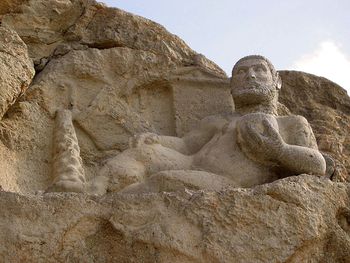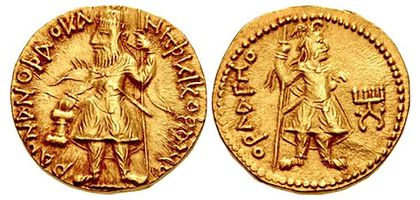「ウルスラグナ」の版間の差分
(→私的考察) |
|||
| (同じ利用者による、間の19版が非表示) | |||
| 27行目: | 27行目: | ||
=== ''バフラム・ヤシュト''の中で === | === ''バフラム・ヤシュト''の中で === | ||
ウルスラグナへの賛美歌であるヤシュト14は、「保存状態は悪いが、非常に古風な要素を含んでいる」とされる<ref>Boyce, 1975, p63</ref>。そこでは、ウルスラグナは「最も高度な武装」(ヤシュト14.1)、「力ある最高の装備」(同13)、「発泡性の栄光」(同3)、「征服する優位性」(同64)を持ち、人間やデーモンと絶えず戦っている(同4、同62)と描写される。ヤシュトは、神性が現れる10の形態を列挙することから始まる。その内訳は、疾風(14.2-5)、武装した戦士(14.27)、15歳の青年(14.17)、残りの7つは動物であり、金の角を持つ雄牛(14. 7)、耳と口が金の白馬(14.9)、発情期のラクダ(14.11-13)、イノシシ(14.15)、猛禽類(veregna, 14.19-21) 、ラム(14.23)、野ヤギ(14.25)である。これらの化身の多くは他の神々とも共通し、例えば、若者、雄牛、馬もティシュトリヤ(Tishtrya)のものとされる。同様に、鳥、ラクダ、風は、武力的勝利を連想させるゾロアスター教のパンテオンのもう一人のメンバーであるヴァーユ・ヴァータ(Vayu-Vata)と共通している。 | ウルスラグナへの賛美歌であるヤシュト14は、「保存状態は悪いが、非常に古風な要素を含んでいる」とされる<ref>Boyce, 1975, p63</ref>。そこでは、ウルスラグナは「最も高度な武装」(ヤシュト14.1)、「力ある最高の装備」(同13)、「発泡性の栄光」(同3)、「征服する優位性」(同64)を持ち、人間やデーモンと絶えず戦っている(同4、同62)と描写される。ヤシュトは、神性が現れる10の形態を列挙することから始まる。その内訳は、疾風(14.2-5)、武装した戦士(14.27)、15歳の青年(14.17)、残りの7つは動物であり、金の角を持つ雄牛(14. 7)、耳と口が金の白馬(14.9)、発情期のラクダ(14.11-13)、イノシシ(14.15)、猛禽類(veregna, 14.19-21) 、ラム(14.23)、野ヤギ(14.25)である。これらの化身の多くは他の神々とも共通し、例えば、若者、雄牛、馬もティシュトリヤ(Tishtrya)のものとされる。同様に、鳥、ラクダ、風は、武力的勝利を連想させるゾロアスター教のパンテオンのもう一人のメンバーであるヴァーユ・ヴァータ(Vayu-Vata)と共通している。 | ||
| + | |||
| + | == 10の化身 == | ||
| + | 『ウルスラグナ祭儀書』によれば、ウルスラグナはアワタールという変身に長け、10種の姿をとってゾロアスターの前に現れたとされる。 | ||
| + | |||
| + | それによりウルスラグナは変身して戦うといわれ、特に力強い[[イノシシ]]の姿をとって戦場で[[ミスラ]]を先導する姿は、宗教画などに好んで描かれた。 | ||
| + | |||
| + | また、鳳(おおとり)の時は霊力に優れ、この羽根を持てば災難除けの呪いになった。この羽根を身体に擦り付けると、悪い呪いを術者に跳ね返す事が出来るといわれる。 | ||
| + | |||
| + | # 強い風 | ||
| + | # 黄金の角を持つ雄[[牛]] | ||
| + | # 黄金の飾りをつけた[[白馬]] | ||
| + | # 鋭い爪と長い毛を持つ俊足の[[駱駝]] | ||
| + | # 鋭い牙をした野[[猪]] | ||
| + | # 十五歳の輝かしい若者 | ||
| + | # 鳳(おおとり) | ||
| + | # 美しい野生の雄[[羊]] | ||
| + | # 鋭い角を持つ[[山羊]] | ||
| + | # 黄金の刃のある剣を持つ人間 | ||
| + | |||
| + | これは[[ヴィシュヌ]]の10の[[アヴァターラ]]に対応するという説がある<ref>『世界神話大事典』<sup>''(要ページ番号、2015-11-03)''</ref>。 | ||
| + | 両者の変化する動物には猪を除いて共通するものが無いが、ゾロアスター教では善悪二元論によって善い動物・悪い動物が規定されていることと、ウルスラグナの成立にオリエント文化の影響があったことなどが背景として考えられる<ref name="Okada"/>。 | ||
=== 他のテキストでは === | === 他のテキストでは === | ||
| 72行目: | 93行目: | ||
アヴェスター語の形容詞ヴェレストラグナン(「勝利する」)が対応するヴェーダ語vrtrahanに「インドラの資格として(圧倒的に)」登場することから、ゾロアスター教徒とヒンドゥー教徒は、インド・イラン時代に戦士神インドラが存在し、アヴェスター語のウルスラグナがその神の姿に類似している可能性があると認めている<ref>Benveniste, Renou, 1934, 要ページ</ref>。ヴェレストラグナのサンスクリット語の同義語はヴリトラグナで、これはヴェーダ文献におけるインドラの愛称であり、彼もまた文字通り障害を意味する名前を持つアシュラである「ヴリトラ」を破壊する者である。 | アヴェスター語の形容詞ヴェレストラグナン(「勝利する」)が対応するヴェーダ語vrtrahanに「インドラの資格として(圧倒的に)」登場することから、ゾロアスター教徒とヒンドゥー教徒は、インド・イラン時代に戦士神インドラが存在し、アヴェスター語のウルスラグナがその神の姿に類似している可能性があると認めている<ref>Benveniste, Renou, 1934, 要ページ</ref>。ヴェレストラグナのサンスクリット語の同義語はヴリトラグナで、これはヴェーダ文献におけるインドラの愛称であり、彼もまた文字通り障害を意味する名前を持つアシュラである「ヴリトラ」を破壊する者である。 | ||
| − | + | しかし、西洋の学者たちはこの同一視に反対している。アヴェスターでは、英雄の戦士神官フェリドゥーンが大蛇アジ・ダハーカ(「アジ」はサンスクリット語の「アヒ」(蛇)と同義であることから、この説の支持者はヴェーダのヴリトラと関連付けている)と戦っている。ある西洋の学者は、ヴェーダでは「英雄」(スーラ)という諡号はほとんどインドラにしか使われず、アヴェスタではスレイタオナやその他の神でない人物に適用されている、と主張している。「勝利者」という言葉は、ウルスラグナに限らず、スレイタオナを含む神と死を宿した他の多くの人物の属性でもある。そして、ヴェーダではソーマを発見したのはインドラだが、アヴェスタでは人間が最初にハオマを搾り、スレイタオナは「薬の発明者」とされるのである。ヴェーダではインドラはヴァジュラで攻撃するが、アヴェスタではヴァジュラはミスラの武器である。 | |
| + | そこで、先史時代の勝利の神に加え、竜を退治する英雄インドラを登場させるという説が生まれたのである。そして、イラン人がそれぞれの人物を独立して保持したのに対し、インド人はこの2つを混同した(トリタ・アプタヤの人物にその名残を残している)。 | ||
| + | この説にも問題がある。特にインドラはミトラやヴァルナと一緒に登場するミタンニ条約において、すでに人間ではなく神格化されていることが明らかであることである。この条約は、リグ・ヴェーダが3神を契約の保護者として呼び出していることを反映しており、これもまたウルスラグナと関連した性質ではないため、さらに疑問が生じている。 | ||
| + | しかし、ベンヴェニステとルヌが示したように、ヴェレストラーガの主要な目的が有害な生物を殺すことではなく、障害物(verethra)を克服すること、特に最も神聖な要素である水(apas)の流れを妨げるのを防ぐことにあるという事実を踏まえれば、最初の説に対する多くの反論が否定され得るだろう<ref>Benveniste, Renou, 1934, p182</ref>。 | ||
| − | + | ポール・ティームはこの主要な特徴に同意したが、バフラム・ヤシュトの豊富な古語的要素は明らかにゾロアスター教以前の時代を示しているが、固有名詞の解釈は「極めて推測的」であり、「インド・アーリア的あるいは古いインド的性格に対する決定的な論拠は得られない」と明言している<ref>Thieme, 1960, p302</ref> <!-- Since "Vedic Indra must be distinguished from a presumable Proto-Aryan ''*Indra'' [of the Mittani treaties]" (302), "we may go so far as to say that the Avestan ''Vərəθraγna'' in his role as the fighting companion of ''Miθra'' is the equivalent of the Vedic Indra in his role as the helper of the ''Adityas''. This does not necessarily mean that ''Vərəθraγna'' has taken the place of Proto-Aryan ''*Indra''; it may just as well mean that Vedic Indra has replaced a Proto-Aryan ''Vərəθraγna''." (312) -->。ベンヴェニステとルヌーの「正確な言語学的・聖書学的分析」を採用したティームは、「原アーリア人の*インドラは、原アーリア人の神*ウルスラグナの機能を引き受けている」と結論付けている。Vrtrahanがインドラの名前であるのは、後のサンスクリット語のテキストだけで、リグ・ヴェーダにはないことを指摘した上で、ティームは「原アーリア語の形容詞*vrtraghanが特に*インドラや他の特定の神と関連していたと考える正当な理由はない」と付け加えている<ref>Thieme, 1960, p312-313</ref>。 | |
| − | |||
| − | |||
| − | |||
| − | |||
| − | |||
| − | |||
| − | |||
| − | |||
| − | |||
| − | |||
| − | * | ||
| − | * | ||
| − | < | ||
| − | |||
| − | |||
| − | |||
| − | |||
| − | |||
| − | |||
| − | |||
| − | |||
| − | |||
| − | |||
| − | < | ||
| − | |||
| − | |||
| − | |||
| − | |||
| − | |||
| + | == 私的考察 == | ||
| + | ウルスラグナは北欧神話のヴァルハラと関連するのではないか。また子音構成からいってオーディンと同起源の神かと思う。 | ||
| + | 個人的には、Verethragnaは兎子(Tùzǐ)に炎(ignis)が加えられた言葉で、最初の子音「T」が略されたものと考える。漢字で表せば「火兎(兎炎、という造語になる)」という意味となろうか。元は火に関する神で、中国神話の[[祝融]]に相当する神かもしれないと思う。北欧神話のオーディン、インド神話のヴィシュヌとは同語源の名前ではなかろうか。 | ||
| − | + | ちなみに、インドラは「イン(天あるいは熊)」+「ドラ(Tù)」という造語で「天兎」あるいは「熊兎」という造語、ヴリトラは「兎(Tù)」の最初の子音「T」が略されたものではないかと思う。ヴリトラはおそらく中国神話の[[共工]]に相当するのではないだろうか。「兎子(Tùzǐ)」の神の穏やかな相・良い相(和魂)をインドラとするならば、荒れ狂う相(荒魂)がヴリトラであると考える。ウルスラグナは英雄であるので、和魂に属する神といえると考える。 | |
| − | |||
| − | |||
| − | |||
| − | |||
| − | |||
| − | |||
| − | |||
| − | |||
| − | |||
| − | |||
| − | |||
| − | |||
| − | |||
| − | |||
| − | |||
| − | |||
| − | |||
| − | |||
| − | |||
| − | |||
| − | |||
| − | |||
== 参考文献 == | == 参考文献 == | ||
* Wikipedia:[https://ja.wikipedia.org/wiki/%E3%82%A6%E3%83%AB%E3%82%B9%E3%83%A9%E3%82%B0%E3%83%8A ウルスラグナ](最終閲覧日:22-12-15) | * Wikipedia:[https://ja.wikipedia.org/wiki/%E3%82%A6%E3%83%AB%E3%82%B9%E3%83%A9%E3%82%B0%E3%83%8A ウルスラグナ](最終閲覧日:22-12-15) | ||
** イヴ・ボンヌフォワ編, 金光仁三郎主幹、安藤俊次ほか共訳, 世界神話大事典, 大修館書店, 2001-03, isbn:978-4-469-01265-1 | ** イヴ・ボンヌフォワ編, 金光仁三郎主幹、安藤俊次ほか共訳, 世界神話大事典, 大修館書店, 2001-03, isbn:978-4-469-01265-1 | ||
| + | * Wikipedia:[https://en.wikipedia.org/wiki/Verethragna Verethragna](最終閲覧日:23-01-04) | ||
| + | ** Vrtra et Vrθragna, Benveniste Émile, Renou Louis, 1934, Paris, Imprimerie Nationale <!-- as cited in Boyce et al. --> | ||
| + | ** Boyce, Mary, History of Zoroastrianism, Vol. I, The early period, 1975, Brill, Leiden, isbn:90-04-10474-7 | ||
| + | ** Boyce, Mary, Mary Boyce, History of Zoroastrianism, Vol. II, Under the Achamenians, 1982, Brill, Leiden, isbn:90-04-06506-7 | ||
| + | ** Religion of ancient Iran, Jacques Duchesne-Guillemin, 1973, Bombay, Tata Press <!--Originally published as ''La religion de l'Iran ancien'' (1962). --> | ||
| + | ** The destiny of the warrior, Dumezil Georges, 1970, Chicago, University of Chicago Press, isbn:0-226-16970-7, https://archive.org/details/destinyofwarrior00dume | ||
| + | ** Bahram in old and middle Iranian texts, Gnoli Gherardo, Encyclopaedia Iranica, volume3, 1989, New York, Routledge & Kegan Paul, pages510–513 | ||
| + | ** Bahrām (Vərəθraγna), Gnoli G., Jamzadeh P., http://www.iranicaonline.org/articles/bahram-1, Encyclopaedia Iranica, Vol. III, Fasc. 5, pages510–514, 1988 | ||
| + | <!-- * Puhvel Jaan, Comparative Mythology, 1989, Baltimore, isbn:0-8018-3938-6, Johns Hopkins University Press --> | ||
| + | ** Lommel Herman, Der arische Kriegsgott, 1939, Frankfurt/Main, Klostermann | ||
| + | ** The 'Aryan' Gods of the Mitanni Treaties, Thieme Paul, Journal of the American Oriental Society, volume80, issue4, <!--Oct-Dec-->1960, pages301–317, doi:10.2307/595878, jstor:595878 | ||
| + | ** West Edward William, Marvels of Zoroastrianism: The Bahman Yasht, 1880, Mülle Friedrich Max, SBE, volume5, OUP, xford | ||
| + | ** Zaehner, Richard Charles, Zurvan, a Zoroastrian dilemma, 1955, Clarendon, Oxford, isbn:0-8196-0280-9 | ||
== 関連項目 == | == 関連項目 == | ||
* アレース(スキタイ) | * アレース(スキタイ) | ||
* [[執金剛神|ヴァジュラバーニ]] | * [[執金剛神|ヴァジュラバーニ]] | ||
| + | * [[インドラ]] | ||
| + | * [[ヴリトラ]] | ||
| + | <!--ボイスは、『アヴェスタ』('Vendidad' 10.9)および後期ペルシア語テキスト('Bundahishn' 21.6など)において、「インドラ」が悪魔として具体的に名付けられていることに注目し、異なる過去から継承した要素よりも、個々の発展を見ることが好ましいと付け加えている--><!-- インドラ=悪魔は 1975:62-64 で言及されているが、「好ましい等」(ボイス、1975:283)は誤りである。 --> | ||
== 参照 == | == 参照 == | ||
| 159行目: | 151行目: | ||
[[Category:山羊]] | [[Category:山羊]] | ||
[[Category:道祖神]] | [[Category:道祖神]] | ||
| + | [[Category:類兎]] | ||
2023年1月4日 (水) 18:31時点における最新版

ウルスラグナ(Vərəθraγna、Verethragna)とは、ゾロアスター教において崇拝される英雄神[4][5]。
中性名詞verethragnaは、アヴェスター語のverethra「障害」、verethragnan「勝利」に関連するものである[6]。その代表が「勝利」の神格であるヴェレストラグナであり、「勝利をもたらす神として、ヴェレストラグナは古来最高の人気を誇っていた」のである[7]。ゾロアスター教の中世ペルシャ語では、Verethragnaは𐭥𐭥𐭫𐭧𐭫𐭠𐭭となり、そこからVahram、Vehram、Bahram、Behramなどの変種が派生している。
ヴェーダ語のサンスクリット語と同義語である。ヴェーダの神インドラは、主にインドラの諡号であるvr̥tragmʰ-が名詞verethragna-に対応することから、ゾロアスター教のアヴェスタのウルスラグナに対応すると思われる。
この名前と神格は、アルメニア語のՎահգն Vahagn とՎռամ Vṙamに借用され、仏教のソグド語wšɣn w(i)šaɣn、Manichaen Parthianの𐭅𐭓𐭉𐭇𐭓𐭌 wryḥrm Wahrām, クシャンバクトリアン ορλαγνο Orlagnoに類縁関係がある[8]。ヴィシュヌ、マニ教のアダマス、カルデア/バビロニアのネルガル、エジプトのホルス、ヘレニズムのアレース、ヘーラークレースなど、ヴィシュヌの姿は非常に複雑だが、その類似性も指摘されている。
目次
概要[編集]
ウルスラグナの名は勝利を意味し、アヴェスター語形で、パフラヴィー語ではワルフラーン(Varhrān)といい、「障害を打ち破る者」を意味する。他の別名にアルタグン、ワフラームやバフラームがある。 語源的にインド神話の神インドラの形容語ヴリトラハンと共通しており[9]、ウルスラグナの成立に関しては、イランでインドラが悪魔の地位に降ろされた結果、形容語だけが独立した神格として崇拝され続けたという説と、イランに存在したウルスラグナの原型となる神とインドラがヴェーダが成立する際に合体したという説がある[9]。
ゾロアスター教神学に於いては中級神ヤザタに分類される。男性神格としてイメージされ、特に戦争の勝利を司る神で、虚偽者や邪悪なる者に罰を与え自らを崇拝するものには勝利を与えるという。 戦う両軍の間に四枚の翼を広げてウルスラグナが降り立った時は、最初にこの神を崇めた方が勝利をおさめるといわれる。 またペルシア7曜神では火星神とされる。
教祖ゾロアスター自身が説いたとされる『ガーサー』には、ウルスラグナは特定の神格としては登場していない。ヘレニズム色の強いパルティア王国の時代になると、ギリシア神話のヘーラクレースと同一視され盛んに信仰された[9]。
サーサーン朝ペルシアでは帝王の性格を持つ戦勝の神として熱心に崇拝され、バフラームの名を持つ王も数名現れている[9]。その初代皇帝アルダシール1世は、自らウルスラグナの聖火を建立し、以後、サーサーン歴代の皇帝達が参詣した。また、この時代から現在に至るまでウルスラグナは道路や旅程を守る神として信仰されている[9]。
アルメニアの民族的英雄神ヴァハグン(Vahagn)はウルスラグナが起源で、怪物ヴィシャップを殺す。
聖典の中で[編集]
バフラム・ヤシュトの中で[編集]
ウルスラグナへの賛美歌であるヤシュト14は、「保存状態は悪いが、非常に古風な要素を含んでいる」とされる[10]。そこでは、ウルスラグナは「最も高度な武装」(ヤシュト14.1)、「力ある最高の装備」(同13)、「発泡性の栄光」(同3)、「征服する優位性」(同64)を持ち、人間やデーモンと絶えず戦っている(同4、同62)と描写される。ヤシュトは、神性が現れる10の形態を列挙することから始まる。その内訳は、疾風(14.2-5)、武装した戦士(14.27)、15歳の青年(14.17)、残りの7つは動物であり、金の角を持つ雄牛(14. 7)、耳と口が金の白馬(14.9)、発情期のラクダ(14.11-13)、イノシシ(14.15)、猛禽類(veregna, 14.19-21) 、ラム(14.23)、野ヤギ(14.25)である。これらの化身の多くは他の神々とも共通し、例えば、若者、雄牛、馬もティシュトリヤ(Tishtrya)のものとされる。同様に、鳥、ラクダ、風は、武力的勝利を連想させるゾロアスター教のパンテオンのもう一人のメンバーであるヴァーユ・ヴァータ(Vayu-Vata)と共通している。
10の化身[編集]
『ウルスラグナ祭儀書』によれば、ウルスラグナはアワタールという変身に長け、10種の姿をとってゾロアスターの前に現れたとされる。
それによりウルスラグナは変身して戦うといわれ、特に力強いイノシシの姿をとって戦場でミスラを先導する姿は、宗教画などに好んで描かれた。
また、鳳(おおとり)の時は霊力に優れ、この羽根を持てば災難除けの呪いになった。この羽根を身体に擦り付けると、悪い呪いを術者に跳ね返す事が出来るといわれる。
- 強い風
- 黄金の角を持つ雄牛
- 黄金の飾りをつけた白馬
- 鋭い爪と長い毛を持つ俊足の駱駝
- 鋭い牙をした野猪
- 十五歳の輝かしい若者
- 鳳(おおとり)
- 美しい野生の雄羊
- 鋭い角を持つ山羊
- 黄金の刃のある剣を持つ人間
これはヴィシュヌの10のアヴァターラに対応するという説がある[11]。 両者の変化する動物には猪を除いて共通するものが無いが、ゾロアスター教では善悪二元論によって善い動物・悪い動物が規定されていることと、ウルスラグナの成立にオリエント文化の影響があったことなどが背景として考えられる[9]。
他のテキストでは[編集]
ウルスラグナは、チェスターとともに、ミスラの主要な仲間である(Mihr Yasht 10.70)。バフラム・ヤシュトのいくつかの部分は、他の神々に捧げられた讃美歌にも登場するが、それらの部分がどの方面から写されたかを特定することはほとんど不可能である。
ヤシュト14章に登場するウルスラグナがイノシシであることから、イリヤ・ガーシェヴィッチは、アヴェスター語のミスラ讃歌に登場するイノシシ、ダームイシュ・ウパマナをウルスラグナの分身と見立てた[12]。
文化・伝統の中で[編集]
ゾロアスター教のヒエラルキーにおいて[編集]
ゾロアスター教の神格構成において、バフラムは光明を司るアムシャ・スプンタのアーシャ・ヴァヒシュタ(アヴェスター語、中ペルシア語ではアルドヴァヒシュタ)を補佐する存在であり、バフラムはこのアーシャ・ヴァヒシュタを補佐する。 アケメネス朝時代後期(紀元前648〜330年)に制定されたゾロアスター教の暦では、月の20日はバフラムに捧げられている(Siroza 1.20)。
中世ペルシャの文献では、バフラムはアムシャ・スプンタの一人として特に崇められ、アンラ・マンユを追い返すのに成功したことで事実上の高位を与えられている[13][14]。
惑星の名前として[編集]
ササン朝(224-651CE)の天文・暦学改革では、火星はバフラムと名付けられた。ゼーナーは、バビロニアのネルガルは戦争の神であり、赤い惑星の名前でもあるというカルデアの星神学体系と習合的なな影響を受けていると考えている[15]。
火の階級の名において[編集]
ボイスによれば、最も神聖なクラスの火の名前として現在使われている「アタッシュ・ベーラム(Atash-Behram)」という表現は、形容詞の「勝利の火(Victorious Fire)」と「バフラムの火(Fire of Bahram)」が混同されたものだという[16]。前者はカバ・イ・ザルドゥシュトのカルティール碑文など中世ペルシャの碑文に見られる方法で、後者は現在アタッシュ・ベラムという言葉で理解されているものである。グノーリは、「イスラム時代にはゾロアスター教の司祭の教えが徐々に衰退し、自然な誤解が生じた。」と分析している[17]。
美術・図像学において[編集]
カルマニア人が勝利の神(Geographika, 15.2.14)を崇拝していたという唯一の証拠は、1世紀のストラボの記述に現れている(おそらくネアルコスによる)。ストラボが言うように、バフラム/ヴェレストラグナが彼らの「唯一の神」であったとすれば、これがバフラム/ヴェレストラグナである可能性は低い要出典、April 2015。しかし、この記述から、イラン高原以外の人々にも戦争の神々が知られていたことがわかる。その証拠に、ヘロドトス(4.59.62)にもその記述がある。
セレウコス朝(前330-150)とアルサス朝(前250-226)の時代、つまりヘレニズム文化の影響を受けた帝国では、ウルスラグナはアーレースと同一視され、ヘーラークレースと結び付けられ、ギリシャ語でアルタグネス(Artagnes)と名づけられた[18]。このような習合は彫像や図像によく現れており、特にコンマゲネのアンティオコス1世テオスの碑文には、3つの名前が一緒に出てくる。
バフラムが旅人の守護神とされていたことは、ベヒストンの幹線道路にある等身大のバフラムの岩像が物語っているのかもしれない。そこでバフラムは、手にゴブレット、足元に棍棒、下にライオンの皮を敷いて寝転んでいる。
ササン朝初期には、バフラムはやはりギリシャのヘーラークレスに相当する神として表現されている。ナクス・エ・ラジャブIIIにあるアルデシール1世のレリーフでは、バフラムはアフラ・マズダと王の間の2人の小さな人物の1人として登場している(要出典)。そこでは、左手に獅子の皮を持ち、右手に棍棒を振りかざしている。もう一人の小さな人物 -バフラムに敬意を表しているように見える- は、後の国王バフラム1世である。
バフラムはまた、ササン朝諸王の冠の中に翼、あるいは猛禽類として登場している。この図像は、バフラム2世の王冠に初めて登場し、神々の名前も記されている。同じようなイメージは、ペロズ(名前も「勝利」を意味する)やホスラウ・パーウェズ(これも「永遠の勝利」を意味するパーウェズ)にも採用されている。同様に、帽子に描かれたイノシシやワシの頭は、王子たちの頭上に冠されている。猪の姿はササン朝美術に広く見られ、織物から漆喰、銀製の装飾品、貨幣、印章に至るまで、あらゆるものに描かれている。その他、バフラムの側面を想起させる動物モチーフも発見されている(前掲『アヴェスタ』におけるバフラムの10の姿参照)。また、ササン朝時代の火祭壇に描かれた鳥のモチーフもバフラムを表すと考えられている。
王の名として[編集]
バフラムはササン朝時代の内、6人の王の名前となっている。
- バフラム1世, r. 271–274. シャプール1世の息子で後継者
- バフラム2世, r. 274–293. バフラム1世の息子で後継者
- バフラム3世, r. 293. バフラム2世の息子で後継者
- バフラム4世, r. 388–399. シャプール3世の息子で後継者
- バフラム5世, r. 420–438. ヤズデゲルト1世の息子で後継者。
- バフラム・コビン, r. 590 - 591. ホルミズド4世の後継者。
アヴェスター学において[編集]
神性の解釈は、倫理的、道徳的、宗教的価値の根本的な革命を反映した起源説であるため、かつてゾロアスター教の研究においてより広く議論された分野の一つであった[19]。
アヴェスター語の形容詞ヴェレストラグナン(「勝利する」)が対応するヴェーダ語vrtrahanに「インドラの資格として(圧倒的に)」登場することから、ゾロアスター教徒とヒンドゥー教徒は、インド・イラン時代に戦士神インドラが存在し、アヴェスター語のウルスラグナがその神の姿に類似している可能性があると認めている[20]。ヴェレストラグナのサンスクリット語の同義語はヴリトラグナで、これはヴェーダ文献におけるインドラの愛称であり、彼もまた文字通り障害を意味する名前を持つアシュラである「ヴリトラ」を破壊する者である。
しかし、西洋の学者たちはこの同一視に反対している。アヴェスターでは、英雄の戦士神官フェリドゥーンが大蛇アジ・ダハーカ(「アジ」はサンスクリット語の「アヒ」(蛇)と同義であることから、この説の支持者はヴェーダのヴリトラと関連付けている)と戦っている。ある西洋の学者は、ヴェーダでは「英雄」(スーラ)という諡号はほとんどインドラにしか使われず、アヴェスタではスレイタオナやその他の神でない人物に適用されている、と主張している。「勝利者」という言葉は、ウルスラグナに限らず、スレイタオナを含む神と死を宿した他の多くの人物の属性でもある。そして、ヴェーダではソーマを発見したのはインドラだが、アヴェスタでは人間が最初にハオマを搾り、スレイタオナは「薬の発明者」とされるのである。ヴェーダではインドラはヴァジュラで攻撃するが、アヴェスタではヴァジュラはミスラの武器である。
そこで、先史時代の勝利の神に加え、竜を退治する英雄インドラを登場させるという説が生まれたのである。そして、イラン人がそれぞれの人物を独立して保持したのに対し、インド人はこの2つを混同した(トリタ・アプタヤの人物にその名残を残している)。
この説にも問題がある。特にインドラはミトラやヴァルナと一緒に登場するミタンニ条約において、すでに人間ではなく神格化されていることが明らかであることである。この条約は、リグ・ヴェーダが3神を契約の保護者として呼び出していることを反映しており、これもまたウルスラグナと関連した性質ではないため、さらに疑問が生じている。
しかし、ベンヴェニステとルヌが示したように、ヴェレストラーガの主要な目的が有害な生物を殺すことではなく、障害物(verethra)を克服すること、特に最も神聖な要素である水(apas)の流れを妨げるのを防ぐことにあるという事実を踏まえれば、最初の説に対する多くの反論が否定され得るだろう[21]。
ポール・ティームはこの主要な特徴に同意したが、バフラム・ヤシュトの豊富な古語的要素は明らかにゾロアスター教以前の時代を示しているが、固有名詞の解釈は「極めて推測的」であり、「インド・アーリア的あるいは古いインド的性格に対する決定的な論拠は得られない」と明言している[22] 。ベンヴェニステとルヌーの「正確な言語学的・聖書学的分析」を採用したティームは、「原アーリア人の*インドラは、原アーリア人の神*ウルスラグナの機能を引き受けている」と結論付けている。Vrtrahanがインドラの名前であるのは、後のサンスクリット語のテキストだけで、リグ・ヴェーダにはないことを指摘した上で、ティームは「原アーリア語の形容詞*vrtraghanが特に*インドラや他の特定の神と関連していたと考える正当な理由はない」と付け加えている[23]。
私的考察[編集]
ウルスラグナは北欧神話のヴァルハラと関連するのではないか。また子音構成からいってオーディンと同起源の神かと思う。
個人的には、Verethragnaは兎子(Tùzǐ)に炎(ignis)が加えられた言葉で、最初の子音「T」が略されたものと考える。漢字で表せば「火兎(兎炎、という造語になる)」という意味となろうか。元は火に関する神で、中国神話の祝融に相当する神かもしれないと思う。北欧神話のオーディン、インド神話のヴィシュヌとは同語源の名前ではなかろうか。
ちなみに、インドラは「イン(天あるいは熊)」+「ドラ(Tù)」という造語で「天兎」あるいは「熊兎」という造語、ヴリトラは「兎(Tù)」の最初の子音「T」が略されたものではないかと思う。ヴリトラはおそらく中国神話の共工に相当するのではないだろうか。「兎子(Tùzǐ)」の神の穏やかな相・良い相(和魂)をインドラとするならば、荒れ狂う相(荒魂)がヴリトラであると考える。ウルスラグナは英雄であるので、和魂に属する神といえると考える。
参考文献[編集]
- Wikipedia:ウルスラグナ(最終閲覧日:22-12-15)
- イヴ・ボンヌフォワ編, 金光仁三郎主幹、安藤俊次ほか共訳, 世界神話大事典, 大修館書店, 2001-03, isbn:978-4-469-01265-1
- Wikipedia:Verethragna(最終閲覧日:23-01-04)
- Vrtra et Vrθragna, Benveniste Émile, Renou Louis, 1934, Paris, Imprimerie Nationale
- Boyce, Mary, History of Zoroastrianism, Vol. I, The early period, 1975, Brill, Leiden, isbn:90-04-10474-7
- Boyce, Mary, Mary Boyce, History of Zoroastrianism, Vol. II, Under the Achamenians, 1982, Brill, Leiden, isbn:90-04-06506-7
- Religion of ancient Iran, Jacques Duchesne-Guillemin, 1973, Bombay, Tata Press
- The destiny of the warrior, Dumezil Georges, 1970, Chicago, University of Chicago Press, isbn:0-226-16970-7, https://archive.org/details/destinyofwarrior00dume
- Bahram in old and middle Iranian texts, Gnoli Gherardo, Encyclopaedia Iranica, volume3, 1989, New York, Routledge & Kegan Paul, pages510–513
- Bahrām (Vərəθraγna), Gnoli G., Jamzadeh P., http://www.iranicaonline.org/articles/bahram-1, Encyclopaedia Iranica, Vol. III, Fasc. 5, pages510–514, 1988
- Lommel Herman, Der arische Kriegsgott, 1939, Frankfurt/Main, Klostermann
- The 'Aryan' Gods of the Mitanni Treaties, Thieme Paul, Journal of the American Oriental Society, volume80, issue4, 1960, pages301–317, doi:10.2307/595878, jstor:595878
- West Edward William, Marvels of Zoroastrianism: The Bahman Yasht, 1880, Mülle Friedrich Max, SBE, volume5, OUP, xford
- Zaehner, Richard Charles, Zurvan, a Zoroastrian dilemma, 1955, Clarendon, Oxford, isbn:0-8196-0280-9
関連項目[編集]
参照[編集]
- ↑ Visscher Marijn S., Beyond Alexandria: Literature and Empire in the Seleucid World, 2020, Oxford University Press, isbn:978-0-19-005908-8, page75, note 26, https://books.google.com/books?id=4yntDwAAQBAJ&pg=PA75
- ↑ Gnoli, Jamzadeh, 1988, pp510–514
- ↑ Rowland Benjamin, page89, The art of Central Asia, date1975, New York, Crown, https://archive.org/details/artofcentralasia00rowl/page/89/mode/2up
- ↑ Sara Kuehn, The Dragon in Medieval East Christian and Islamic Art: With a Foreword by Robert Hillenbrand, https://books.google.com/books?id=AZWgdBCgmLYC, 12 July 2011, BRILL, isbn:978-90-04-18663-7, page103
- ↑ Bert G. Fragner, Proceedings of the Second European Conference of Iranian Studies: Held in Bamberg, 30th September to 4th October 1991, by the Societas Iranologica Europaea, https://books.google.com/books?id=-y46AQAAMAAJ, 1995, Istituto italiano per il Medio ed Estremo Oriente
- ↑ Gnoli, 1989, p510
- ↑ Boyce, 1975, p63
- ↑ Orlagno, British Museum, https://www.britishmuseum.org/collection/term/BIOG132106, www.britishmuseum.org
- ↑ 9.0 9.1 9.2 9.3 9.4 9.5 岡田明憲、松枝到(編)「古代イランの動物変身」『象徴図像研究:動物と象徴』 言叢社 2006 ISBN 4862090079 pp.101-114.
- ↑ Boyce, 1975, p63
- ↑ 『世界神話大事典』(要ページ番号、2015-11-03)
- ↑ Gershevitch, 1959, pp166–169; pro Gnoli, 1989, p511; contra Boyce, 1975, p. 83, n. 416
- ↑ de Menasce, 1948, p5-18
- ↑ Gnoli, 1989, p513
- ↑ Zaehner, 1955, p147
- ↑ Boyce, 1982, p222
- ↑ Gnoli, 1989, p512
- ↑ Duchesne-Guillemin, 1984
- ↑ Boyce, 1975, p62-64
- ↑ Benveniste, Renou, 1934, 要ページ
- ↑ Benveniste, Renou, 1934, p182
- ↑ Thieme, 1960, p302
- ↑ Thieme, 1960, p312-313


